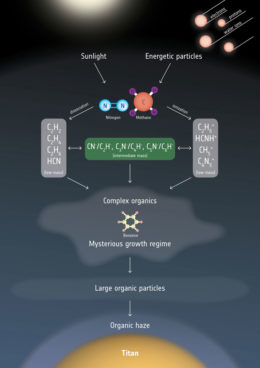Editor’s note: In these last two weeks of 2017, we’ll be looking at a few selections that we haven’t yet discussed on AAS Nova from among the most-downloaded papers published in AAS journals this year. The usual posting schedule will resume in January.
Carbon Chain Anions and the Growth of Complex Organic Molecules in Titan’s Ionosphere
Published July 2017
Main takeaway:

Graphic depicting some of the chemical reactions taking place in Titan’s atmosphere, leading to the generation of organic haze particles. [ESA]
Why it’s interesting:
Carbon chain anions are the building blocks of more complex molecules, and Titan’s thick nitrogen and methane atmosphere might mimic the atmosphere of early Earth. This first unambiguous detection of carbon chain anions in a planet-like atmosphere might therefore teach us about the conditions and chemical reactions that eventually led to the development of life on Earth. And if we can use Titan to learn about how complex molecules grow from these anion chains, we may be able to identify a universal pathway towards the ingredients for life.
What we’ve learned so far:
Cassini measured fewer and fewer lower-mass anions the deeper in Titan’s ionosphere that it looked — and at the same time, an increase in the number of precursors to larger aerosol molecules further down. This tradeoff strongly suggests that the anions are indeed involved in building up the more complex molecules, seeding their eventual growth into the complex organic haze of Titan’s lower atmosphere.
Citation
R. T. Desai et al 2017 ApJL 844 L18. doi:10.3847/2041-8213/aa7851
